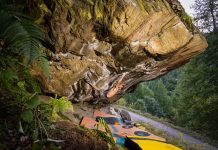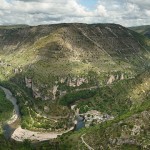Drilled cam slots on First and Last WallUKC News, Jul 2010© Nic Sellers CollectionNic Sellers Discovers Drilled Slots in Beautiful Granite Wall:Last year Cornish activist Mark Edwards climbed a new route called First and Last Wall at Lands End, Cornwall. The route, graded E8 6b/c by Edwards, climbs a stunning blank wall of Cornish granite.A photograph of the route appeared in Climb magazine last summer with a long write-up from Mark in which he stated:“I knew about this wall since the early 80's… at the time the smallest cam available were friend one's, and they are far too big for the tiny pockets… I had a look and found that the smaller cams now available do just about fit in the shallow pockets…“Sheffield based climber Nic Sellers has just made a flying visit to Cornwall to repeat the route. Here he takes up the story:“Last week I was on a short trip to Cornwall visiting my friend Shane Ohly, who has recently moved to down there. We went to Lands End to climb as Shane was keen to have a look at a new Mark Edwards route called 'First and Last Wall, which he had given E8 6b/c. This route was heralded as a last great problem.I rapped the route and was appalled to see a series of five blatantly drilled 1cm x 3cm x 3cm slots evenly spaced down the route. These would provide the only protection for the meat of the route. Small cams fit perfectly in the slots. I had never come across such slots on granite around Cornwall or the world and there were no others on the wall itself.Shane top roped the route and I flashed it, placing the cams as I went, feeling the grade to be nearer E6, perhaps 7, depending on how loose you thought the rock was. The climbing was only F6c but the rock rather loose and friable.Having completed the route I inspected the slots in detail and took photo's. As a result of their perfectly parallel nature, their convenient positioning and drill bit marks at the back of the slots I am entirely convinced of their manufacture/ enhancement.The route in its original form would have been a fantastic bold proposition somewhere in the region of its claimed grade of E8, but as it is, the original challenge has been taken away and the rock has been irreparably tarnished.“Photo Gallery – Drilled Cam Slots:
UKC contacted Mark Edwards, who is a regular UKC forum user, for his comments. Mark stated that the drilling was nothing to do with him, and he was saddened by the event:“Very sad to hear about this, There was no drilling going on for any cam placements for my ascent. I had seven witnesses during my cleaning and ascent and I am sure they would also state this fact too. It's a shame if the route has been messed around with, it would not be the first time it's happened in West Penwith. The route has been there since last summer, and I have been over here in Spain since then.“Mark Edwards is correct in his statement that other routes in Cornwall have been damaged by drilling, chipping and bolting, many of them Mark Edwards' own routes. The ethics of Cornish granite do not permit chipping or bolting, however the ethics were in flux in the eighties as styles developed and grades were pushed.Mark Glaister is a long time Cornwall climber and ex-Devon resident. He has just written the new Rockfax guidebook to the area and is familiar with the ethics and history of Cornish climbing. Glaister commented:“The debate over drilled gear on West Penwith granite goes way back to the first bolts used on Beowulf at Bosigran in 1966 – these were subsequently eliminated and it was not until the 80's that drilled gear came to be used once more in the form of bolts and drilled peg and thread placements.I myself climbed and clipped a lot of the drilled gear around the time of the routes first ascents such as the pegs and threads on A Perfect Lady (1986) and Flash Control (1990) (A Perfect Lady took the arete right of Yankee Doodle and bit the dust in the storm that obliterated Yankee Doodle).A well rehearsed debate over the use of drilled protection raged in the district for a number of years and the up shot now (and has been for a long while) is that all drilled gear is not welcome on the granite. The placement of the drilled gear has never been hidden or concealed – however the chipping of holds on Sennen's main buttress has never been resolved and the recent discovery of manufactured cam placements has once again bought the unwelcome spectre of tampering by those unknown to the fore.“Glaister is referring to the route Red Rose, at Sennen Cove, which was claimed as a sport route by Mark Edwards at F8b/c back in 1988. The bolts were chopped (lots of bolt debates were going on at that time in Cornwall) and the route was toproped by Andy Pollit in 1989. Pollit discovered chipped holds and thought the route to be much easier than the proposed F8b/c. The route has since been repaired and still awaits a re-ascent. The identity of the chipper was never proven, but was the cause of much debate.Mark Edwards and his father Rowland developed their own drilled protection system, which they trialled out in Spain. The system, called ENP, consisted of a mechanism that was placed in to a drilled hole in the rock, in to which a micro wire could be placed. It was essentially like bolting a route, but without the bolts. The system never went main stream, but you can see a video of Mark Edwards climbing a route in Spain – placing the ENP protection below:VIDEO: Mark Edwards climbing The Prayer to the Raven and the Crow, on Echo 2, Costa Blanca The identity of the modern mystery chipper is unknown, as with the chipper of Red Rose, but they should be aware that placement enhancement or drilling of any kind is not acceptable on Cornish granite and they are responsible for damaging a potentially classic route. Diesen Artikel inkl. Bilder auf UKClimbing.com anschauen



![[VIDEO] Irmgard Braun: Record Breaking Rock Climber Who Gets Stronger Every Year Irmgard Braun: Record Breaking Rock Climber Who Gets Stronger Every Year (c) Hannah Morris Bouldering](https://www.climbing.de/wp-content/uploads/2025/11/youtube_MpAJEENfEjg-218x150.jpg)

![[VIDEO] The Challenge – Steve McClure The Challenge - Steve McClure (c) Petzl Sport](https://www.climbing.de/wp-content/uploads/2025/11/youtube_mfK9ynVsDvI-218x150.jpg)
![[VIDEO] Silence 9c/5.15d – The journey begins for Will Bosi Silence 9c/5.15d - The journey begins for Will Bosi (c) William Bosi](https://www.climbing.de/wp-content/uploads/2025/11/youtube_ujb7YRfE-7k-218x150.jpg)
![[VIDEO] Yosemite Crack Testpiece: Connor Herson on Magic Line Yosemite Crack Testpiece: Connor Herson on Magic Line (c) Fusis Films](https://www.climbing.de/wp-content/uploads/2025/10/youtube_h4GEt5iSZpA-218x150.jpg)
![[VIDEO] Hardest Trad Flash Ever | Adam Ondra | Lexicon E11 Hardest Trad Flash Ever | Adam Ondra | Lexicon E11 (c) Mammut](https://www.climbing.de/wp-content/uploads/2025/06/youtube_SAUyrDLG5xM-218x150.jpg)
![[VIDEO] Jonathan Siegrist Breaks The 'Speed' Limit | Nomad](https://www.climbing.de/wp-content/uploads/2014/12/epictv_600306-150x150.jpg)












